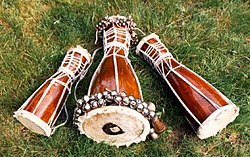Batá drum

Batá drums (from left: Okónkolo, Iyá, Itótele) (photo courtesy Harold Muñiz)
|
|
| Percussion instrument | |
|---|---|
| Classification | Percussion |
| Hornbostel–Sachs classification | 211.242.12 (Individual double-skin hourglass-shaped drums, both heads played) |
| Musicians | |
| Irakere, Julito Collazo | |
A Batá drum is a double-headed drum shaped like an hourglass with one end larger than the other. The percussion instrument is used primarily for the use of religious or semi-religious purposes for the native culture from the land of Yoruba, located in Nigeria, as well as by worshippers of Santería in Cuba, Puerto Rico, and in the United States. The Batá drum's popular functions are entertainment and to convey messages. Its early function was as a drum of different gods, drum of royalty, drum of ancestors and drum of politicians. Batá drum impacted on all spheres of life.
Several different types of drums have existed throughout the world. Occasionally, natives from cultures which the drums originate, as in the case of the Yorùbá, used the drums for religious ceremonies and, since their introduction in Cuba in the 1820s, have come to be an understood and important part of the perceived culture of the southwestern Nigerian people.
The drum dates back roughly 500 years, and is believed to have been introduced by a Yoruba king named Shangó el rey del tambor. Despite the previous long history, awareness of the instrument didn't spread until the 1800s slave-trade in which close to 300,000 Africans were brought to Cuba. The religion and beliefs the Yorùbá brought with them eventually became the basis for what is known as Lukumí (or Santería in Cuba). This religion spawned the creation of the first "sacred" Batá in Cuba around 1830 by a Yorùbá named Añabi.
The Batá slowly became inducted into the Cuban culture after a time, and began to take on more secular uses: they were first publicly performed in 1935 in a broadcast over Cuban radio for purposes of folklore music. Uses such as this have grown as knowledge of the instrument has spread; more and more musicians not currently practising Lukumí have used versions of the drums in recordings or performances. These "non-sacred" Batá drums are called aberínkula—profane Batá (see Sacred-profane dichotomy). Batá drums and rhythms have started to be used in other genres, most notably in Cuban timba, jazz and hip hop. In the 1970s, for instance, a mixture of Batá drums and Big Band called Son-Batá or Batá Rock became popular, a genre highly influenced by Irakere.
...
Wikipedia
